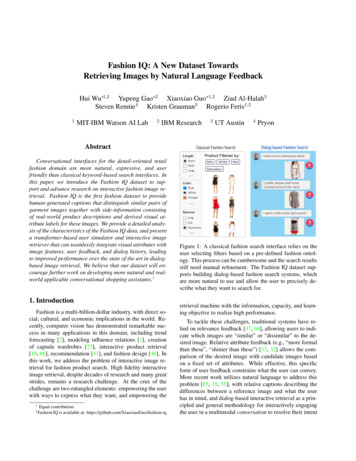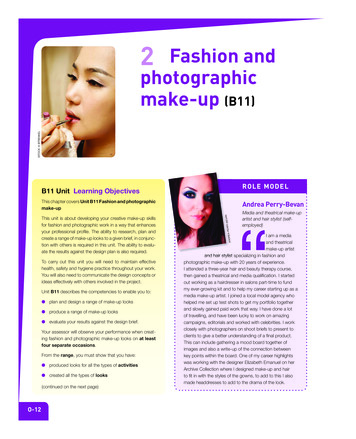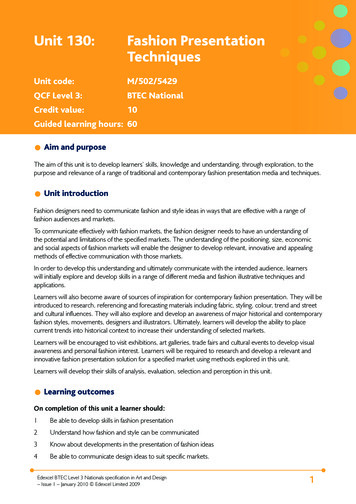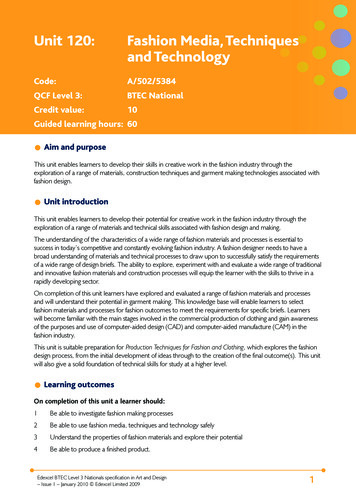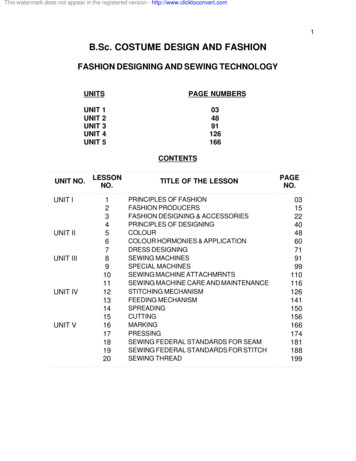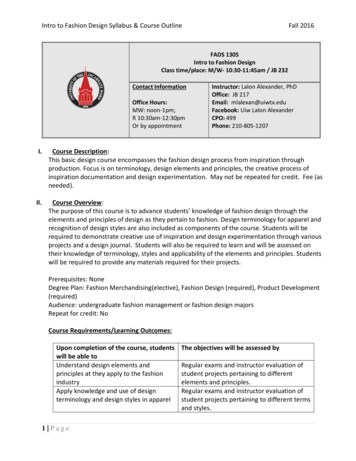
Transcription
Intro to Fashion Design Syllabus & Course OutlineFall 2016FADS 1305Intro to Fashion DesignClass time/place: M/W- 10:30-11:45am / JB 232Contact InformationOffice Hours:MW: noon-1pm;R 10:30am-12:30pmOr by appointmentInstructor: Lalon Alexander, PhDOffice: JB 217Email: mlalexan@uiwtx.eduFacebook: Uiw Lalon AlexanderCPO: 499Phone: 210-805-1207I.Course Description:This basic design course encompasses the fashion design process from inspiration throughproduction. Focus is on terminology, design elements and principles, the creative process ofinspiration documentation and design experimentation. May not be repeated for credit. Fee (asneeded).II.Course Overview:The purpose of this course is to advance students’ knowledge of fashion design through theelements and principles of design as they pertain to fashion. Design terminology for apparel andrecognition of design styles are also included as components of the course. Students will berequired to demonstrate creative use of inspiration and design experimentation through variousprojects and a design journal. Students will also be required to learn and will be assessed ontheir knowledge of terminology, styles and applicability of the elements and principles. Studentswill be required to provide any materials required for their projects.Prerequisites: NoneDegree Plan: Fashion Merchandising(elective), Fashion Design (required), Product Development(required)Audience: undergraduate fashion management or fashion design majorsRepeat for credit: NoCourse Requirements/Learning Outcomes:Upon completion of the course, studentswill be able toUnderstand design elements andprinciples at they apply to the fashionindustryApply knowledge and use of designterminology and design styles in apparel1 PageThe objectives will be assessed byRegular exams and instructor evaluation ofstudent projects pertaining to differentelements and principles.Regular exams and instructor evaluation ofstudent projects pertaining to different termsand styles.
Intro to Fashion Design Syllabus & Course OutlineApply knowledge and use of the designprocess in the fashion industryShow consistent growth throughout thesemester in design techniques and skillIII.Fall 2016Instructor assessment of the quality of thedesign process documented by the studentthrough projects and a journalInstructor evaluation of studentimprovement and growth throughoutsemester and entirety of projects, exams,and homework.Course Texts/Supplies/Materials:A. Required Text: Aspelund, K. (2015). Designing: An introduction. Fairchild Books: New York City. Rothman, S. (2016). The fashion designer’s sketchbook. Fairchild Books: New YorkCity.B. Supplies: Color Wheel* Prang watercolor set* Notebook and writing utensil for notes Pencil for drawing eraser Other supplies will be needed for certain projects. Please see the projectdescription for a list of supplies needed. Refer to the schedule to see when you shouldbring certain project supplies.*Indicates that supplies are provided for student through course feesIV.Course Policies:Participation, Punctuality and AttendanceSpecial Note:As the fashion industry is one of the most competitive career areas in the U.S., it is essentialto develop professional habits and strong work ethics early in order to significantly increaseyour chances of success. Among these habits are attendance, punctuality, honesty,integrity, completing all work entirely and on time, respect for others and enthusiasm foryour work. As such, many of the course policies reflect these and are set to engrain thesehabits into your way of life as early as possible, making you a much more employableperson.A. Attendance Policy:University PolicyUnless otherwise stated in the course syllabus/outline, or unless an absence is excused inaccordance with this policy, students are expected to attend and participate in all scheduledclass meetings. Students taking on-line courses are expected to show active participation inthe course as defined in the course syllabus/outline. Faculty are expected to communicateclass attendance and participation requirements in the course syllabus/outline. Students2 Page
Intro to Fashion Design Syllabus & Course OutlineFall 2016are responsible for meeting the attendance and participation requirements in each course.If there are any questions or concerns over the requirements, students should speakdirectly to the faculty at the beginning of the semester.Policy requirements1. Notification of Facultya. Planned Absences. Students must notify instructors in writing at least twoweeks prior to planned absences such as participation in an official universityfunction, observance of a religious holy day or active military service. If theabsence is for the observance of a religious holy day see Class Absences forReligious Holy Days policy. If the absence is for military service the studentshould provide to each instructor a copy of the military orders (see #2.b. belowregarding extended absences due to military service).b. Illness or other extenuating circumstances. Students should notify theinstructor directly of absence due to illness or other extenuating circumstance.2. Making up missed worka. With instructor permission, make-up exams and assignments will be scheduledby the instructor within a reasonable time. Make-up exams and assignments willbe equivalent to and no more difficult than the original assignments.b. A student who misses multiple class periods should seek advice from theinstructor about the advisability of continuing in the course or requesting anIncomplete grade (if the student is otherwise eligible for an Incomplete).3. Withdrawing from a coursea. Students who are not able to attend a course are responsible for dropping thecourse by the appropriate deadline. Instructors may not automatically drop astudent from a course. Students who do not attend and who do not officiallydrop the course will receive a failing grade for the course.4. Disputes and Appealsa. If there are disagreements about absences that cannot be resolved between thestudent and the instructor the student should contact the Office of the Dean ofthe College or School who has oversight for the respective course. The StudentComplaint Policy is found in the Student Handbook & Code of Conduct.5. Communication of Policya. The policy and procedure are to be printed in the UIW Student Handbook &Student Code of Conduct.b. International Student & Scholar Services will include the policy in theInternational Student Handbook and Welcome Week literature.c. The policy will be included in the Faculty Handbook (Chapter 7 Policies andProcedures on Instruction).d. The policy will be included in the Undergraduate and Graduate Bulletins under“Attendance”.3 Page
Intro to Fashion Design Syllabus & Course OutlineFall 2016Fashion Management Department Policy for Lecture Classes:Attendance and participant in this class is mandatory. In addition to maintaining theappropriate average in any class, ATTENDANCE WILL AFFECT THE FINAL GRADE IN THEFOLLOWING WAYS:As this class meets only once a week, students are allowed 1 absence from this courseduring the semester. Each additional absence will result in the loss of 5% from your finalcourse average. (Department Policy).Absences and Tardies:An Attendance Sheet will be located at the front of the classroom. After the officialbeginning of class the sheet will be marked and all subsequent signatures will be consideredtardy. It is YOUR responsibility to sign in – not the instructor’s. Students that are in class,but did not sign in are still considered absent.Three tardies equal one absence. If a student misses more than 15 minutes of class they areconsidered ABSENT regardless of whether it is at the beginning, during or at the end ofclass. If you leave within the last 15 minutes, but before you are dismissed, you are tardy.ALL absences count regardless of being excused or unexcused. However, an excusedabsence will allow you to make up missed work, whereas an unexcused absence does not.An excused absence is defined as a verified illness, family emergency, religious observance,or University-sponsored event. A doctor’s note is required for an illness to be excused.Notice of funeral or some other form of official documentation is needed for familyemergencies. ALL UNDOCUMENTED ABSENCES are unexcused.Documentation:All excused absences must be accompanied by proper documentation within ONE WEEK ofthe student’s return from his or her absence. If documentation is not provided within oneweek, the absence will count as unexcused.Officially Approved Trips:The University of the Incarnate Word Catalog states that the person responsible for astudent missing class due to a trip should notify the instructors of the departure and returnschedule in advance of the trip. The student may not be penalized and is responsible forthe material missed. (p.66)Religious Observances:University Policy:The University of the Incarnate Word welcomes persons of diverse backgrounds and istherefore committed to providing reasonable accommodations for students wanting toattend religious observances even though they may conflict with university class meetings,assignments, or examinations. This policy is intended to ensure that both faculty and4 Page
Intro to Fashion Design Syllabus & Course OutlineFall 2016students are fully aware of their rights and responsibilities in the accommodation ofstudents' religious observances.Policy Requirements1. Notification of FacultyStudents must inform instructors in writing at least two weeks before the religiousholy days or religious activities, but preferably at the beginning of the semester, toenable planning and coordination of class assignments and examinations. In someprofessional schools the Dean’s approval will also be required.2. Making up missed worka. With instructor permission, make-up exams and assignments will be scheduledto be completed before the religious observance if possible or within areasonable and specified time after the observance;b. Make-up work must be equivalent to and no more difficult than the originalassignments;c. It is not appropriate to excuse a student from make-up work and consequentlyreduce the student’s grade;d. Students are not required to prove attendance at religious observances in orderto complete make-up work and complete a courses;e. Because of time limitations at the end of the semester, this policy does not applyto the final exam period; student do have the option of requesting an incompletegrade (IP) for the course if the religious observance occurs at the end of thesemester.3. Disputes and AppealsShould disagreements arise over any aspect of this policy, the student or instructorshould contact Office of the Dean of the College or School that has oversight overthe respective course. The procedures for the Student Complaint Policy are found inthe UIW Student Handbook & Student Code of Conduct.4. Communication of Policya. The policy and procedure above are to be printed in the UIW Student Handbook& Student Code of Conduct.b. International Student & Scholar Services will include the policy in theInternational Student Handbook and Welcome Week literature.c. The policy will be included in the Faculty Handbook (Chapter 7 Policies andProcedures on Instruction).d. The policy as stated above will be included in the Undergraduate and GraduateBulletins under “Attendance”.e. Faculty will include the following statement in the course syllabus and announcethe procedure the first day of class.Class Absences for Religious ObservancesThe University of the Incarnate Word welcomes persons of diverse backgrounds and istherefore committed to providing reasonable accommodations for students wanting toattend religious observances and who will miss class. Students must inform instructors5 Page
Intro to Fashion Design Syllabus & Course OutlineFall 2016at least two weeks prior to attending a religious observance. Students use the formfound in the UIW Student Handbook & Student Code of Conduct to requestaccommodations from the instructor.***PERFECT ATTENDANCE*****Anyone who completes the semester without ANY absences (excused or unexcused) ORtardies of any sort will receive and extra 1/3 letter grade to their overall average. Forexample, if you have a B- for your final course grade and a perfect attendance record, youwill be “bumped” to a B.Class Participation: Participation in all classes is expected and required. All work isexpected to be turned in on time.B. Late Assignments:LATE ASSIGNMENTS WILL NOT BE ACCEPTED. Absolutely NO late assignments or projects willbe accepted except from those who have an excused absence (excluding Universityapproved absences). Those with University-approved absences must turn in their projectsBEFORE the absence unless other arrangements are made prior to the absence. Any otherwork that is not turned in on time or early will not be accepted and therefore will berecorded as a zero (0) in the gradebook. Those with an EXCUSED absence (must haveproper documentation – see absence policy) must submit their work by the beginning of thenext class period. Those who have skipped class and do not have acceptabledocumentation of illness or family emergency will not have this grace period.C. Communications/Information:All information for homework, assignments or projects can be found on Blackboard or theclass website: www.lalonalexander.com If you have lost your information, or ahard copy was not given in class, you can print one out from either site. If one site is down,the other site can still be accessed.Announcements will be made in class, through Blackboard and Facebook. It is the student’sresponsibility to check their UIW email (including junk mail folder) for announcements anddirect communications from the instructor. Students should also friend the instructor andjoin the Facebook class group, UIW FADS Intro to Design, to keep up with announcementsand any date changes.It is the student’s responsibility to read the directions fully to complete each project orassignment. If you do not understand the directions in anyway, ASK THE INSTRUCTOR. “Ididn’t know that’s what you meant,” is not an excuse.All assignments and projects are due at the beginning of class on the dates given. Noassignments or projects will be accepted after the beginning of class on the assigned date.All projects and assignments must be original. They cannot be re-used from another class.6 Page
Intro to Fashion Design Syllabus & Course OutlineFall 2016NOTE: You are responsible for any changes to the project/assignment specifications madeorally in class. Please pay attention when projects are being reviewed, ask ahead of time ifyou want to get started early and find out if you missed anything when absent.D. Performance Level:To obtain an “A” in this course, the student must maintain accuracy as well as a high level ofcreativity in all of their projects. In addition, every project is to be on time, and have nomore than1 excused absence. Only the highest-level students will receive an “A”. Simplybeing present and turning in assignments does not “entitle” one to an “A”. Nor does it“entitle” one to any other passing grade. Only absolute excellence in work and a terrificattitude as well as other factors earns one an “A”. Even just to receive a passing grade willrequire a lot of hard work and diligence to meet the requirements of the course and theassignments. A passing grade does not mean that the project was merely completed, butthat it was also deemed acceptable by the instructor and met ALL of the guidelines.NOTE: Any student is welcome and encouraged at any time during the semester to inquireabout assignment questions, his/her attendance, his/her grades, questions about lectures,or any other concerns. It is not acceptable to email the instructor (for the first time thatsemester) after the final asking if there is anything he/she can do to raise his/her grade.E. Disability Accommodations:The University of the Incarnate Word is committed to providing a supportive, challenging,diverse and integrated environment for all students. In accordance with Section 504 of theRehabilitation Act – Subpart E, Title III of the Americans with Disabilities Act (ADA), and TitleIII of the ADA Amendments Act of 2008 (ADAAA), the University ensures accessibility to itsprograms, services and activities for qualified students with documented disabilities. Toqualify for services, the student must provide Student Disability Services with theappropriate documentation of his or her disability at the time services and/oraccommodations are requested.Pregnancy Accommodations:Under the Department of Education’s (DOE) regulations implementing Title IX of theEducation Amendments of 1972, the University does not discriminate against any studenton the basis of pregnancy or pregnancy related conditions.To request reasonable accommodations for disability, temporary disability (e.g., injury,surgery) or pregnancy, please contact:Student Disability Services4301 Broadway CPO 286Administration Building – Suite 105San Antonio, TX 78209(210) 829-3997(210) 829-60787 Page
Intro to Fashion Design Syllabus & Course OutlineFall 2016www.uiw.edu/sdsTitle IX InformationUnlawful discrimination has no place at the University of the Incarnate Word. It violates theUniversity’s core values, including its commitment to equal opportunity and inclusion, andwill not be tolerated. The University of the Incarnate Word prohibits sexual misconduct,that can include: (1) sex and gender based discrimination; (2) sexual and sex and genderbased harassment (including a hostile environment based on sex or gender); (3) sexualassault; (4) sexual exploitation; (5) stalking; and (6) relationship violence (including datingand domestic violence). For more information, or to report an incident, please visitwww.uiw.edu/titleix.F. UNIVERSITY OF THE INCARNATE WORD FASHION MANAGEMENT CODE OF CONDUCTIn the spirit of the Sisters of Charity of the Incarnate Word and the mission of thisUniversity, the fashion department has accepted as its charger for the 2006-2007 academicyear, the pursuit of the value of respect; personal, departmental and universal.We intend to implement this value by-Treating each other with courtesy-Attempting to recognize the divine in each one of us-Recognizing the dignity of each individualThe Incarnate Word of God teaches us to treat ourselves, our peers, our superiors, and ourcommunity with thoughtful consideration. Thoughtfulness in our words and actions can domuch to create a positive and successful learning environment.NB: The following rules are in addition to the University of the IncarnateWord Student Code of Conduct published in the student handbook, availablein the Student Activities Office.G. ACADEMIC HONESTY STATEMENTThe highest standards of academic honesty are expected in the course. Forms of academicdishonesty include, but are not limited to cheating, plagiarism, counterfeit work,falsification of academic records, unauthorized reuse of work, theft, collusion. See thestudent handbook for definitions and procedures for investigations of claims of academicdishonesty.Forms of Academic Dishonesty (including but not limited to): Cheating on tests, examinations or other class or laboratory work Involvement in plagiarism (appropriation of another’s work and the unacknowledgedincorporation of that work in one’s own written work offered for credit)8 Page
Intro to Fashion Design Syllabus & Course Outline V.Fall 2016Counterfeit work, including turning in as one’s own, work which was created,researched or produced by someone elseFalsification of Academic Records- knowingly and improperly changing grades ontranscripts, grade sheets, electronic data sheets, class reports, projects, or otheracademically related documentsUnauthorized reuse of work- turning in of the same work to more than one classwithout the consent of the instructors involvedTheft- unauthorized use or circulation of tests or answer sheets specifically prepared fora given course and as yet not used or publicly released by the instructor of the course,or theft of completed testsCollusion- involvement in collusion (unauthorized collaboration with another person inpreparing course work)Facilitating Academic Dishonesty – intentionally or knowingly helping or attempting tohelp another to violate a provision of the code of academic integrityDepartment Information.A. GRADING OF GARMENTS (and Assignments/Projects) Garments (Assignments/Projects) must be entirely completed to be graded Grading will be based on quality according to the rubrics (specifications) for eachconstruction course The student will have to have a C or better to proceed to the next level in the fashiondegree plan No late work or extra credit will be accepted IPs will only be issued in extreme circumstancesNB: The student will have to earn a C or better to proceed to the next level in the fashiondegree plan.B. CLASSROOM AND LAB USE:Students are to respect the rights of others by treating faculty and classmates with respect.They are to respect the property of others and to use departmental supplies and equipmentcarefully.In addition, please READ AND KEEP YOUR SYLLABUS No food or drink in the sewing or computer labs No sleeping in class Students should refrain from any unnecessary disruptive talking during class (facultyencourage an open environment in which everyone has the right to express their ownopinions and ideas). However, everyone should be able to do so without having to talkover any of their peers in order to be heard Silence cell phones, pagers, PDA phones in classrooms9 Page
Intro to Fashion Design Syllabus & Course Outline Fall 2016No portable video game systems during classNo laptops unless they are part of the on-going lessonNo working on unrelated topics in classNo walking in front of the teacher while they are teachingOnly students enrolled in the class may be in the classroom during classNo late workDepartmental supplies are for in-class workNo leaving the classroom during lecture except in the case of emergency. It is justconsidered impolite to walk out while someone is lecturing or presenting, plus you arelikely to miss vital information.C. Teaching StrategiesPlease read the assignments before coming to class. The reading assignments, lecturediscussions and projects are intended to complement each other. This course, as with mostfashion courses, is extremely rigorous, and if you are current with your reading you will getmore out of your class time. Ask questions. Chances are if you are confused, so are others.At times you all will be confused, so maintain your sense of humor.The syllabus presents the anticipated schedule, however the time schedule is not written instone. Although I expect to keep to the dates in general, I like to allow some flexibility. Theraising of questions during class time is welcomed and encouraged. If I don’t have theanswer to your question I will try to obtain it within a reasonable period of time. I hopethat each of you will share your experiences and knowledge with the class. If anyinstructions or assignments are not clear, please ask me about them so that I can clarify anypotential problems for all students in the course.VI.Grading Activities, Criteria, and GuidelinesA. Grading Activities:Projects and Assignments:Exams: There will 3 exams during the semester to test students’ knowledge of terminologyand processes.Make up exams will only be given for documented, excused absences. Any make up examswill be in essay format, and scheduled with the instructor. You must make up exams withinone week of returning to class. 10 P a g eExtra credit for exams: Each student has the opportunity to add 3 points on an examby attending a UIW Fashion Society meeting. Professional organizations are standardin the fashion industry as they are a great way to keep up with industry trends,current research, and network with peers. The UIW Fashion Society is a studentstepping stone to career professional organizations. For each meeting you attend(for the full meeting) and sign in, you will receive 3 points on your upcoming exam.o 1 meeting will only count for 1 exam
Intro to Fashion Design Syllabus & Course OutlineFall 2016o 1 meeting will only count for 1 course (if other courses offer credit forattending)o You must stay for the entire meetingo You must sign in to receive creditDesign Journal: A visual and written documentation of your own design process. This willinclude inspirations, designs, materials and other sources of creativity. This will be turned inperiodically during the semester for homework grades. Refer to project directions for a fullexplanation.Assignments: Various assignments relating to specific class lessons will be assignedthroughout the semester. Refer to project directions for a full explanation.In-Class Work and Pop Quizzes: students will be graded on their participation and workcreated in-class. This includes discussion participation. Students will also periodically have apop quiz over the reading assignments. There are no make-up quizzes, but one quiz gradewill be dropped at the end of the course.20-Time Project: The entire class will work together to develop a fashion-related servicelearning project. The class will determine the project parameters and grading requirementswith guidance from the instructor.Fashion Line Project: Each student will create a small line of apparel for a specific market.Trends, inspiration, pricing, and materials must all be rationalized by the student. Refer toproject directions for a full explanation. The Line Project will count as the final project.B. Grading Criteria: ExamsDesign JournalAssignmentsIn-class work/pop quizzes20-time projectFashion Line15%15%15%15%15%25%Total % 100%C. Student Evaluation:Students will be evaluated on their ability to meet the course objectives based on theirfulfillment of the class projects and assignments. This includes:1. Ability to follow directions2. Ability to demonstrate comprehension of subject matter3. Creativity4. Neatness and completeness11 P a g e
Intro to Fashion Design Syllabus & Course OutlineFall 20165. Overall appearance/layout/designGrades are as follows: 93%A4.090 – 92%A3.787 – 89%B 3.383 – 86%B3.080 – 82%B2.777 – 79%C 2.370 – 76%C2.067 – 69%D 1.363 – 66%D1.060 – 62%D0.759% & below F0.0Superior grasp of subject matter, initiative, and originalityBetter than average grasp of subject matterAcceptable grasp of essentials of courseLess than average performance in classFailure to master the minimum essentials of the courseVII. Course OutlineTenative Schedule:DatesTopicAugSeptOct22Course expectations –reading assignmentsHow to read your book/listening24What is design? Process2931571214192120-time/ present assignment 1Guest lecturer: FADS alumni, Heather Fitzgerald**Labor Day – No Class**HistoryElements of designColorPrinciples of designBrainstorming / creative research26283510Market researchDevelopment: Using elements and principles indesignExam 1Presenting to groupsVisual presentations121719Present assignment 220-timeMemorization / study plans12 P a g eReadingAssignments Duefrom textPurchase books &suppliesKA Ch. 1SR. Ch. 1KA Ch. 2KA Ch. 3Assignment 1Journal 1KA Ch. 4KA Ch. 5SR Ch. 2SR Ch. 3SR Ch. 4Exam 1Journal 2KA Ch. 6SR Ch. 5Assignment 2
Intro to Fashion Design Syllabus & Course OutlineNovDecFall 2016242631279142-D design and textiles3-D designExam 2CultureDesigners/styles/garment types20-timeVirtual presentationsKA Ch. 7KA Ch. 816212328Present assignment 3CostingThanksgiving holidayExam 330Present 20-timePresent 20-time510:45am12:45pmMonday - Final Exam Time –(project counts asfinal) JB 232 - Present work to fashion facultyFashion line projectdueKA Ch. 9KA Ch. 10SR Ch. 6Exam 2Journal 3Assignment 3Journal 4Exam 3*** You must be present at the final or you will fail the class. Late projects will not beaccepted nor will early ones. No changes can be made to projects after submission. We will notwait for you. If you are not on time, your final project will not be accepted. You must have tothe discipline to complete your project on time and to get yourself to the presentation ontime.***If you are more than 15 minutes late, your project WILL NOT be accepted. ***VIII.Bibliography:Brannon, E. L. (2011). Designer’s guide to fashion apparel. New York, NY: Fairchild Books.Brannon, E. L. (2010). Fashion forecasting (3rd ed.). New York, NY: Fairchild Books.Jennings, T. (2011). Creativity in fashion design. New York, NY: Fairchild Books.Posner, H. (2011). Marketing fashion. London, UK: Laurence King Publishing.Tortora, P. & Eubank, K. (2010). Survey of historic costume (5th ed.). New York, NY: FairchildBooks.Travers-Spencer, S. & Zaman, Z. (2008). The fashion designer’s directory of shape & style: Over600 mix-and-match elements for creative clothing design. Hauppauge, NY: Barron’sEducational Series.13 P a g e
Intro to Fashion Design Syllabus & Course OutlineFall 2016FADS 1305: Intro to fashion designStudent AgreementI have read the FADS 1305 Syllabus and FashionManagement Code of Conduct. I understand and agree to all the policies therein pertaining tostudent conduct, attendance, classroom use, assignments, late assignments, and theperformance level that is expected of me in this course.Student SignatureStudent Name – Clearly PRINTEDPhone number/cell phoneEmail – if you use another address from your UIW accountMajorClassification in major: Fr So Jr SrOptional Information:I came to UIW because:The class I most look forward is:My dream job is to:14 P a g eDate
Intro to Fashion Design Syllabus & Course Outline Fall 2016 . 1 Page. FADS 1305 Intro to Fashion Design Class time/place: M/W- 10:30-11:45am / JB 232 Contact Information Office Hours: MW: noon-1pm; R 10:30am-12:30pm Or by appointment. Instructor: Lalon Alexander, PhD. Office: JB 217. Emai
